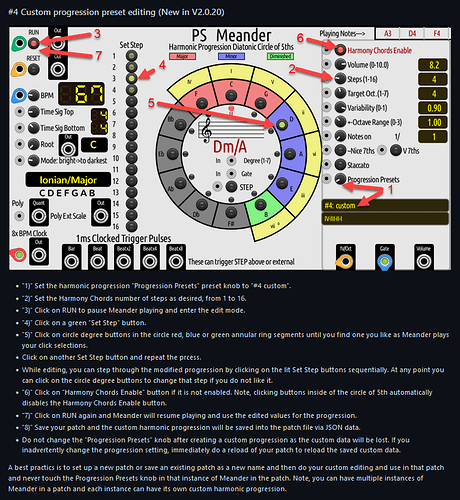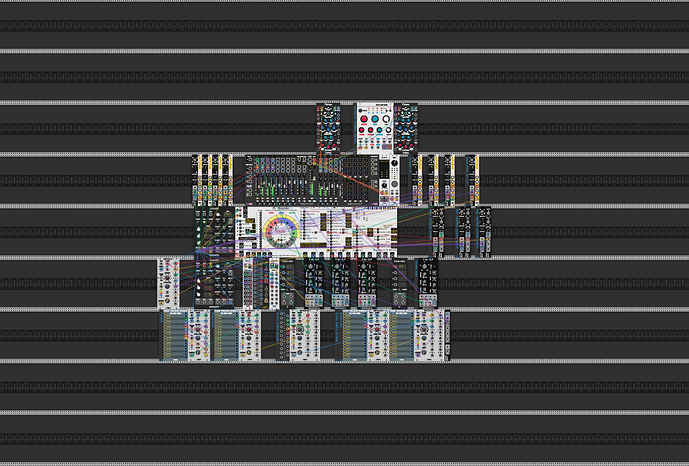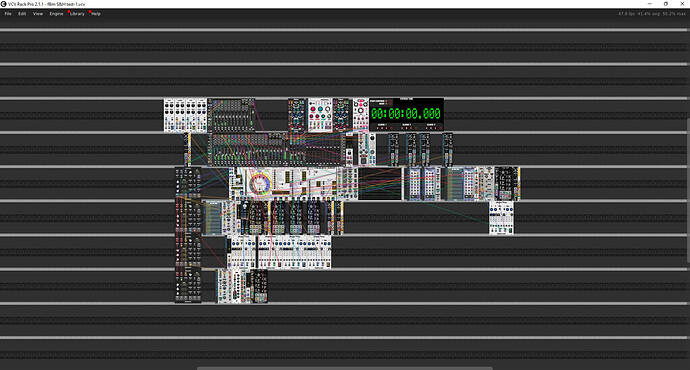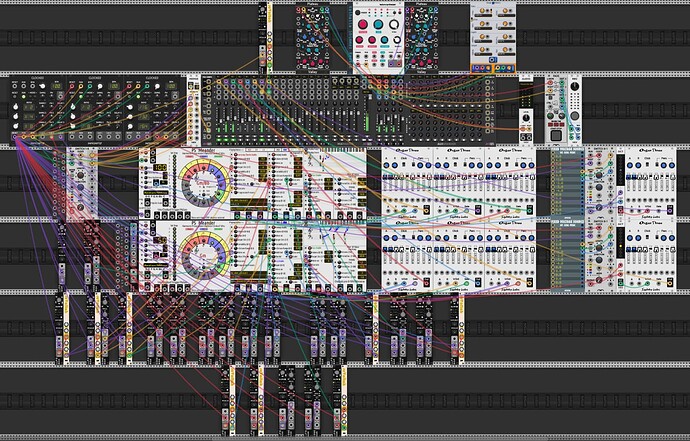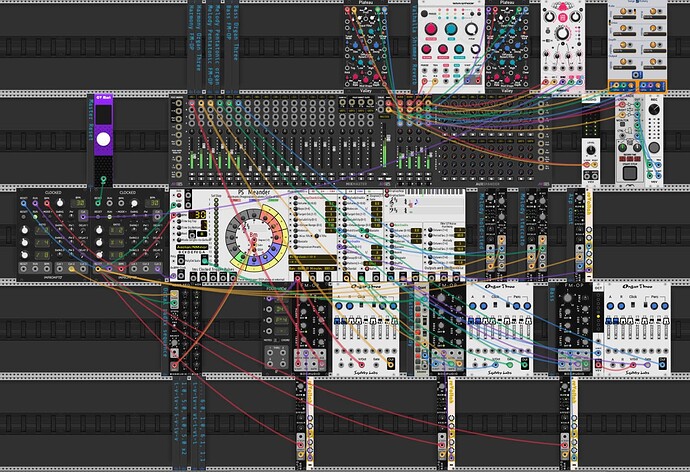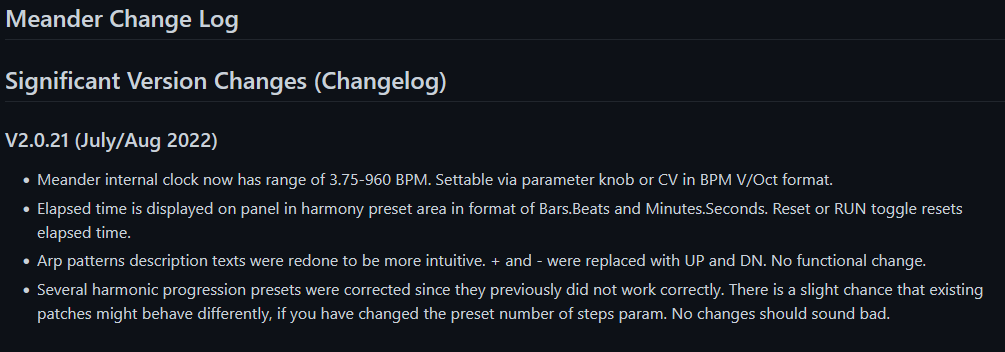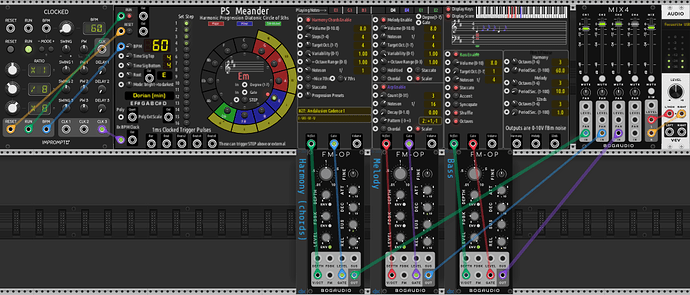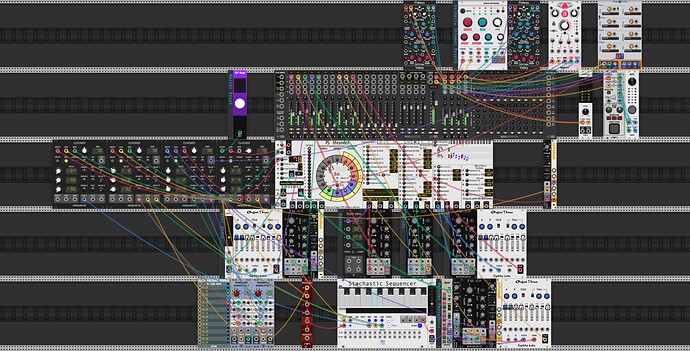So, does anyone know what the “spacing” argument should be set to and what it means when developers use a negative spacing such as -1 or -2? Or 0.0 ?
My guess is that -1 moves the character one point closer together from the default for that font? And 0 gives you the default? I’ve never set it myself, I think I assumed that the vcv context you get already has 0 set in it?
That’s what I imagine. Without definitions, what we imagine may be correct or may be incorrect. The function does what it does. It always bugs me when functions are ill-defined.
If you are interested in trying out or using the Meander harmonic (chords) progression custom preset creation capability, I have uploaded a step by step description to the manual with an image of the panel and with corresponding text describing the 8 steps.
Here is my latest music, entitled “Meander Meander”. This is in Phrygian D and makes use of four FM-OP’s only for voices. This uses Meander’s octal radix control for melody degree sequencing.
Here is my latest classical work, “Meander Chamber Orchestra-1” in Dorian D. Performed with 12 HOST instances playing BBC Symphony Orchestra orchestrated for chamber orchestra.
Here is my latest song, “The Meander 3-Step” with a I-IV-V Markov chain in Am. As usual, this is a generative piece with Meander composing, conducting and performing the 12 tracks. I explored the use of Meander’s fBm noise output with S&H and quantized to the Meander Am pentatonic scale for a melodic line as well as a bass line with OCT sequencing… I automated the fBM “octave” and “period” via CV with time. This is like a 3rd order “drunken walk”. There is also an octave wandering root note drone
Voices are FM-OP, Organ Three and VCV Drums, sequenced via the Meander clocked trigger outputs.
Wait… what?! That module is not in the patch. I actually used the Count Modula FADE module for recording control and time display… but that cannot be read ![]()
I’m working on Meander V2.0.21 at present,including the following enhancements or changes:
- Added an elapsed time display in bars:beats and minutes:seconds, compatible with all time signatures. Time is reset to zero by a RESET or a RUN toggle.
- Reworked the melody arp “Pattern” description display to use “UP and DN” rather than “+ and -”.
- Change BPM allowed range from 30-300 to 3.75-960 via parameter knob or CV.
Does anyone see any possible problems with expanding the BPM range rather dramatically? The current 30-300 BPM range follows the Impromptu CLOCKED ranges. The expanded range is primarily related to running Meander on it’s internal clock, but, CLOCKED can still be used to provide Meander with a 30-300 BPM 1v/octave CV along with the proper 8X clock. It is also possible to always set CLOCKED to 120BPM and then do octave shifts on the BPM output that is input to Meander and then set the CLOCKED x8 clock appropriately, but this is a bit tricky and is an advanced technique which is not necessary if the Meander internal clock is used.
Meander is a low CPU utilization module, averaging 1-3% even at the 3.75 and 960 BPM settings. Through extensive testing, I have not had any problem related to extending the BPM range.
Some pretty neat results can be had by running multiple instances of Meander with each having different BPM settings, allowing “meanders” over very short time periods or very long period.
If you can think of any reason this BPM range increase would cause problems, please post here.
Thanks
I should clarify that although Meander currently operates in the 30-300 BPM range when used with CLOCKED, the Meander internal clock operates in the 10-300 BPM range. So, it is more accurate for me to say that I am expanding this internal clock range to 3.75-960 BPM.
Also, since VCV specifiies 1V/oct over a range of -5V to +5V with 120 BPM being 0V, 3.75 BPM represents the lowest possible tempo at -5V. 960 BPM corresponds to +3V, so I could go higher by two octaves, but I doubt that any useful things could be done at 1920 or 3840 BPM but if anyone thinks otherwise, let me know ![]()
Here is my latest musical piece “Rollover Bach”. This is a toccata in Dmin for the organ. There are two instances of Meander set to different BPM which are switched between dynamically by switching the Mindmeld mixer solo tracks on nice clock intervals.
Even though 8 instances of Organ Three were used, only 4 are sounding at any one time. Even though very complex, this would have been playable by Bach as a toccata showing his technical expertise.
There is a lot of parameter CV automation going to, really mixing things up. This was a lot of fun to do ![]()
Here is my latest music composed and performed with Meander. This is basically a i-v-iv-v progression in Bmin. Voices are FM-OP and Organ Three. Chord progression is in octal radix via 4 AS ReStep sequencers. This is an example of sequencing Meander harmonic progressions via external sequencers.
Here is a short demo version of Echoes in Time and Space but using BGA ADDR-SEQ for the octal radix chord sequencing. I am including the patch file here, in case you want to play with Meander harmonic progression degree sequencing. Only free modules are used, I think.
Be sure to click on the patch “Master Reset” button to get everything in sync.
As a reminder, “octal radix” is a decimal format of degree.octave where degree I-VII are represented as 1.x volts through 7.x volts, or 1.0-7.0 for octave 0. A value of 0.0 will be interpreted by Meander as a skip step where the chord is not changed. This will then play the harmonic progression chord in whatever mode and root Meander is set to. The BGA sequencers’ output go to the Meander Circle of 5ths graphic, inside the circle connected to both Degree and Gate input ports. If you were connecting a MIDI keyboard to control the progression, the keyboard V/oct output would go to “Degree” and the keyboard gate output would go to the “Gate”.
When sequencing in this manner, Meander will slave the melody and bass parts to the sequenced chords and more or less accompany the harmony.
You may have to hit the master reset a couple of times to get things in sync. I seem to have an order of initialization problem with this patch between Meander and the BGA ADDR-SEQ.
I may need to modify Meander to handle this type of startup synchronization problem. Temporarily, if you try this patch, you will probably have to wait until the ADDR-SEQ is on the 2nd step before doing a master reset. Things sound very disharmonious until this step. Actually, it works better to just wait for things to get in sync naturally rather than sending the master reset.
Here is a bare-bones patch that shows how to use Meander to generate harmony, melody with arpeggiaton and bass.
Meander Demo Patch-1.vcv (2.6 KB)
Thanks for posting this patch. It provides a very clear demonstration of your excellent module. It’s very kind of you to share this musical device with the community.
Here is my latest music created with my Meander module (and helpers). This is basically a minimalist drone and sequencer song. Sequencing is via the Sha#Bang! Modules Stochastic Sequencer with several CVs automated for variety over time. The sequencer goes through a Grande Quant that is receiving a Bm pentatonic poly external scale from Meander.
This is in Bm and is another song that stays on the circle of 5ths “I” degree, or Bm and its inversions. The drone is the B root note. So, the title is a play on “To B or to wanna B”.
Wonderful piece ![]()
